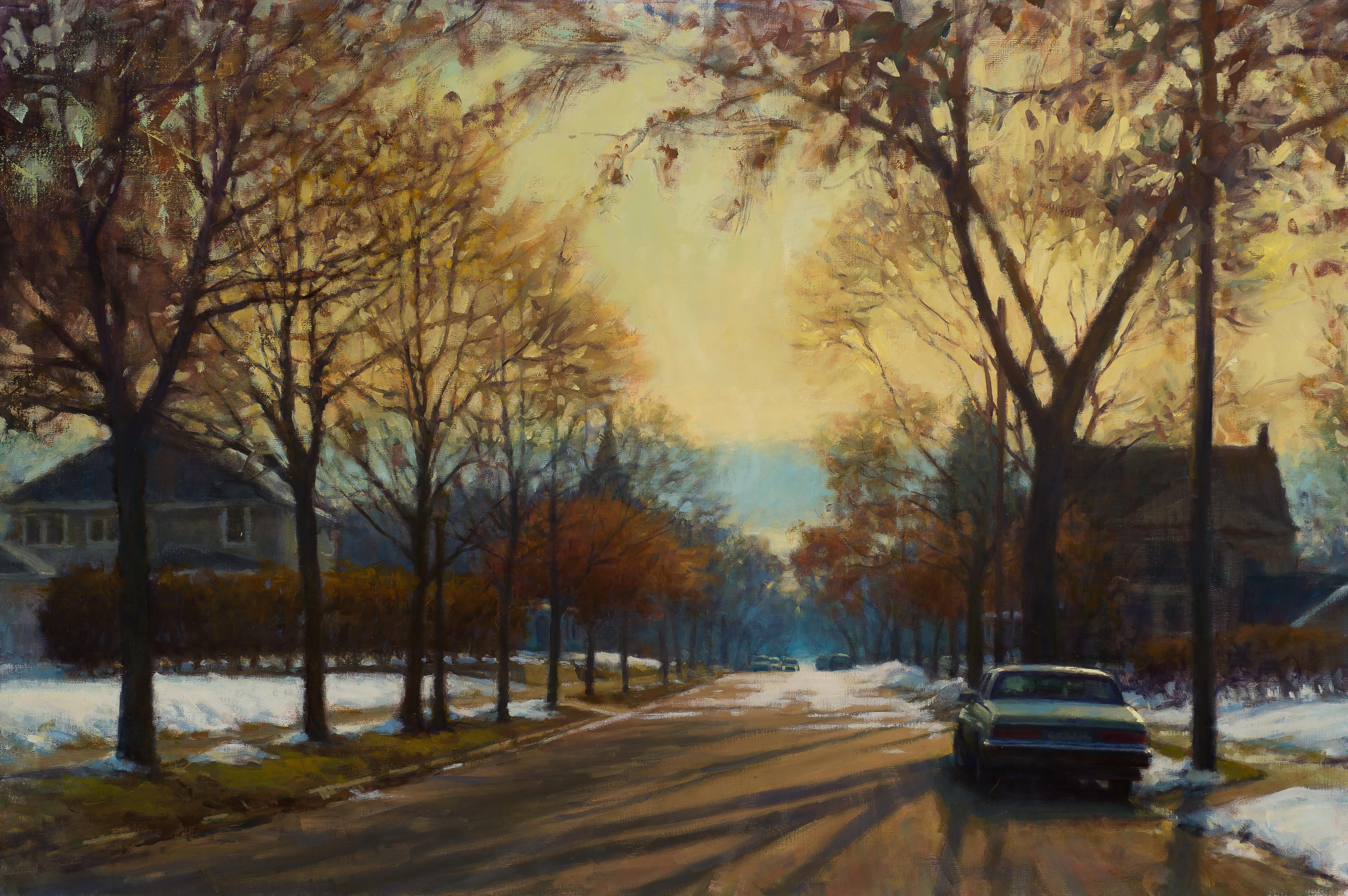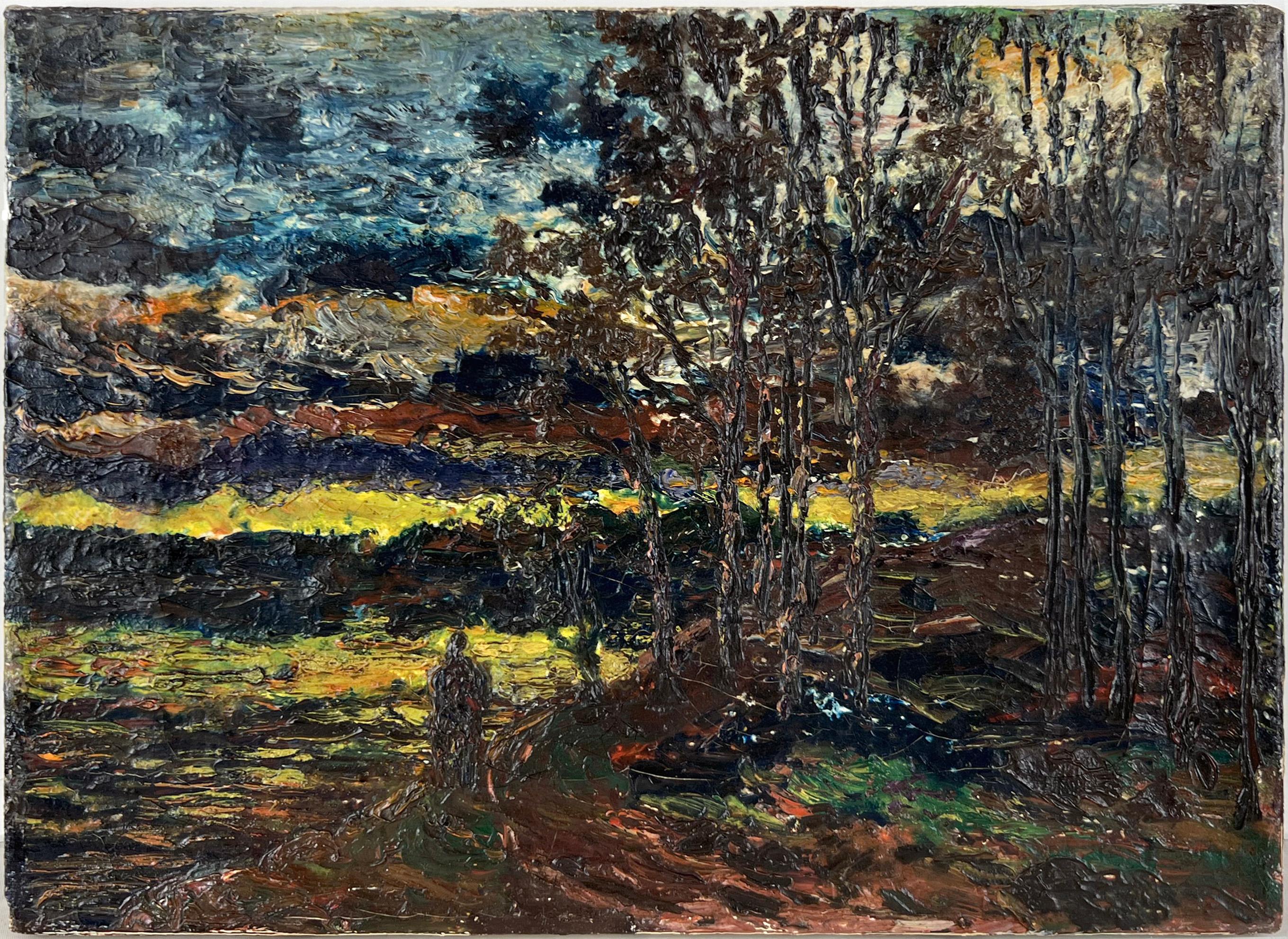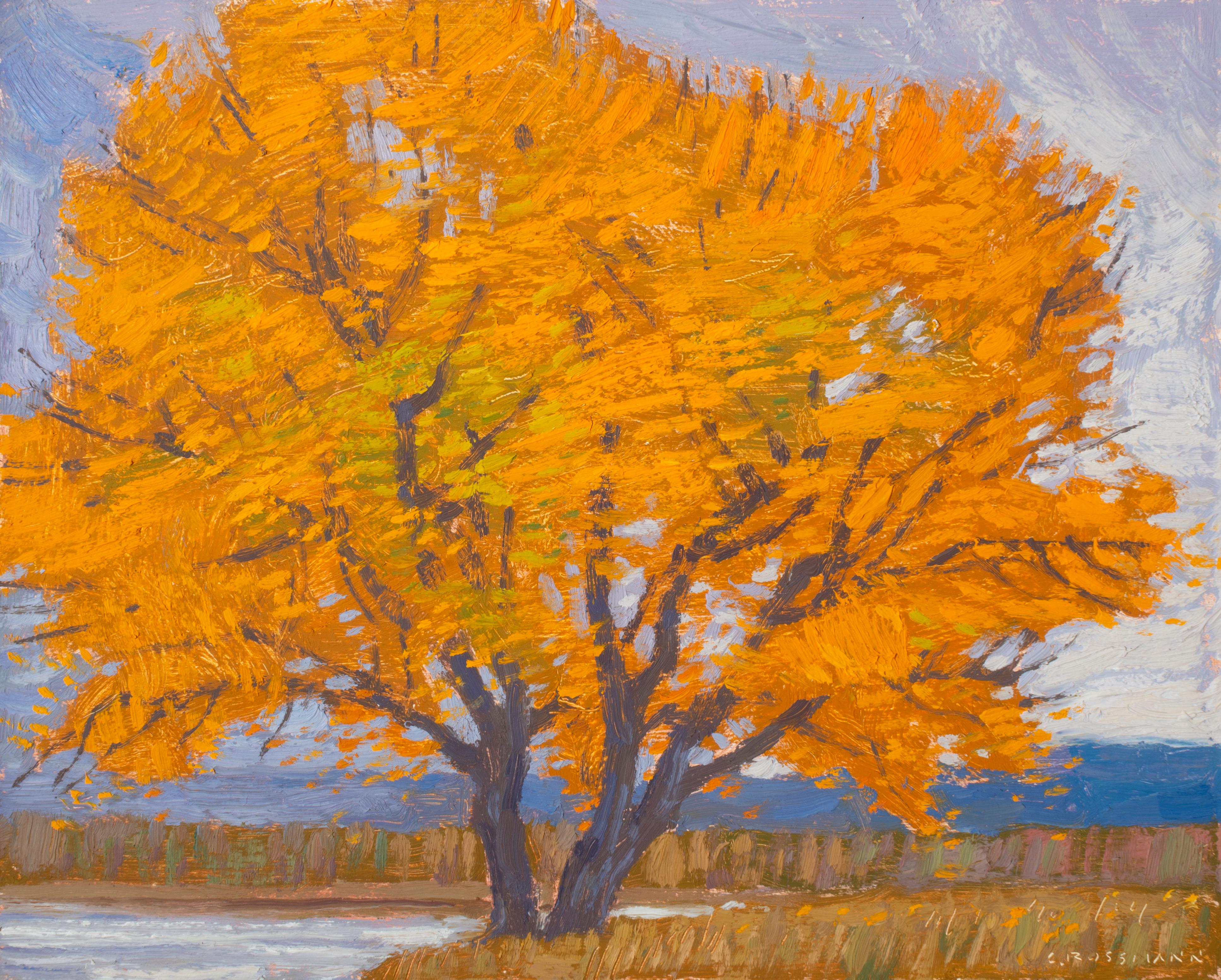Items Similar to Coast Guard Cutter with Cannons Spanish-American War Maritime Original Oil
Video Loading
Want more images or videos?
Request additional images or videos from the seller
1 of 14
William Lindsey ChallonerCoast Guard Cutter with Cannons Spanish-American War Maritime Original Oil 1901
1901
About the Item
Turn of 20th Century Spanish-American War Coast Guard Cutter with Cannons Original Oil Painting
A fine example of maritime ship portraiture oil painting of a Coast Guard Cutter with cannons under sails during the Spanish American War by renowned Nautical British/American painter Captain William Lindsay Challoner (British/American 1852-1901), 1901. Luminous and striking painting with seaman unfurling sails heading into rough waters. Challoner served as captain of a naval vessel (Coast Guard Cutter) during the Spanish-American War. Here he is depicted on the deck of the ship while seamen scramble aloft on the rigging during a gale. The captain stands tall before the cannons at the ready to fend off intruders. His paintings are rare and highly prized by museums and Nautical collectors alike.
Signed: Lower right corner "W. Challoner"
Not framed
Dated: "1910"
Provenance: A local Monterey Bay area estate find.
Condition: Professionally restored (conservation report available)
Image size: 27.75"H x 47.38"W
William Lindsay Challoner lived the peripatetic life of a mariner, spending much of his time at sea, and in ports such as New Orleans and San Francisco, California. He was born in Bedminster, England, and attended the York Naval Academy. In 1880, Challoner married Mary Cadogan. That same year, the couple immigrated to Argentina and then New Orleans. They had one son, William Lindsay Challoner, Jr.
Lloyd’s Lists record Challoner as master aboard J.P. Macheca, a “Clipper Schooner” running bananas from Jamaica during the mid-1880s. The clipper also raced at the Southern Yacht Club in New Orleans. As is often the case, Challoner’s middle name is misspelled as “Lindsey” in J.P. Macheca & Co. records. He is also said to have served as captain for vessels in the Morgan Line.
Painting was at first an avocation for Challoner, but his draftsmanship and handling of paint suggest academic training. He may also have learned to make precise topographical drawings at the York Naval Academy. Many of his ship portraits are in the English tradition, notably followers of Samuel Walker, a leading English maritime artist in the 1850s. Like his Liverpool counterparts, Challoner used receding linear and atmospheric perspective to focus on the crisp portraits of specific ships. At their best, his canvases are highly finished, a style that imitates the Venetian tradition of topographical city views associated with Giovanni Antonio Canal, also known as Canaletto. However, Challoner’s restrained bravura paint handling also may bear witness to the influence of the French Impressionists.
Challoner seems to have arrived in New Orleans about 1880. He advertised in the press and exhibited at the Creole Art Gallery and Grunewald’s Music Store in New Orleans. In 1887, Challoner moved to San Francisco, where he exhibited his maritime scenes at the Mechanic’s Institute and became a U.S. citizen. He may have been back in New Orleans after 1891, and served as captain of a naval vessel during the Spanish-American War. His art clients tended to be men involved in the shipping industry—ship owners and commission merchants, along with professional clubs and maritime benevolent societies.
Challoner’s principal competition in New Orleans was August Norieri, a talented ship portraitist and painter of marines. While Norieri lived hand-to-mouth, Challoner drew a handsome salary working as a ship captain, presumably until shortly before his death at the age of 49. Securing the commission for painting the newly founded New Orleans Yacht Club suggests that Challoner was held in higher regard as an artist than Norieri. The two artists together met the market demand for ship portraiture and marine views in the port city, as had Edward Arnold and James Guy Evans a couple generations before. A few others, such as Edward Hacker, advertised as marine painters, but it remains a mystery why New Orleans did not emerge as a major center for maritime painting during the nineteenth century.
Several paintings bearing Challoner’s signature are held by museums, and works occasionally surface at auction. Challoner’s paintings are in the collections of the Mariners’s Museum in Newport News, Virginia, the Historic New Orleans Collection, and the Louisiana State Museum
- Creator:William Lindsey Challoner (1852 - 1901, American)
- Creation Year:1901
- Dimensions:Height: 27.75 in (70.49 cm)Width: 47.38 in (120.35 cm)Depth: 1 in (2.54 cm)
- Medium:
- Movement & Style:
- Period:
- Condition:Good: Professionally; relined on linen, missing paint retouched, UV-resistant varnish applied. Original stretcher bars used.
- Gallery Location:Soquel, CA
- Reference Number:
About the Seller
4.9
Platinum Seller
These expertly vetted sellers are 1stDibs' most experienced sellers and are rated highest by our customers.
Established in 1986
1stDibs seller since 2014
2,541 sales on 1stDibs
Typical response time: <1 hour
- ShippingRetrieving quote...Ships From: Soquel, CA
- Return PolicyA return for this item may be initiated within 14 days of delivery.
More From This SellerView All
- Sunrise on Nantucket Island Fisherman Gazing at the Sky 1929Located in Soquel, CASunrise on Nantucket Island Fisherman Gazing at the Sky 1929 Nantucket Sunrise, a Fisherman is gazing at the sky by James Francis Barker (American, 1872 – 1950). In the style of Albert Pinkham Ryder (1847 - 1917) was active/lived in New York, Massachusetts. Albert Ryder is known for Romanticism-pastoral landscape painting. Barker has a heavy impasto and extensive brushwork throughout and captures American Post Impressionism with this early sunrise on Nantucket Island scene. Image, 10.25"H x 14.25"W Signed "J. F. Barker" dated "3/29" on Stretcher bar verso Signed James F. Barker on Linen verso James F. Barker’s lineage traces back to eleven of the original Nantucket settlers. He was born in 1872 in Keokuk, Iowa, the son of a railroad ticketing agent and a New Orleanian of Spanish and French extraction. His ancestors on his father's side included 11 of the 15 families who settled Nantucket in 1659. He graduated from Cornell University in 1893 with a degree in Mechanical Engineering and spent another year studying Architecture at the graduate level. He briefly worked at D. H. Burnham & Company and Allis-Chalmers Manufacturing Co. before switching to education, With a degree in mechanical engineering and graduate degree in architecture, his career was centered among institutes of higher learning. Barker was also a skilled painter and a talented photographer. Barker specialized in waterfront, wharf, and beach scenes. The artist exhibited his work during the summer months at the Eagle’s Wing Studio on Union Street, having named the studio after a steamer, which had been captained by his grandfather. James Francis Barker (1872 – 10 December 1950) was the second president of the Rochester Athenæum and Mechanics Institute, succeeding Carleton B. Gibson, from 1916–1919. He also pursued painting, pottery, metal working, and cabinet making. Gravestone in Prospect Hill Cemetery, Nantucket He was born in 1872 in Keokuk, Iowa, the son of a railroad ticketing agent and a New Orleanian of Spanish and French extraction. His ancestors on his father's side included 11 of the 15 families who settled Nantucket in 1659. He graduated from Cornell University in 1893 with a degree in Mechanical Engineering and spent another year studying Architecture at the graduate level. He briefly worked at D. H. Burnham & Company and Allis-Chalmers Manufacturing Co. before switching to education, becoming Superintendent of the Manual Training Department at East Division High School in Milwaukee, Wisconsin in 1897. He left in 1904 to pursue similar positions at Grand Rapids High School and the Hackley School in Muskegon, Michigan. In 1906, he participated in the formation of East Technical High School in Cleveland, Ohio and served as its first principal. He married the former Kate Spooner in 1897 and raised one daughter. After being widowed in the late 1930s, he married Josephine M...Category
1920s American Impressionist Figurative Paintings
MaterialsOil, Linen
- "Christmas Morn" Sleigh in the Snow after W.C Bauer, London Oil on Linen 1937Located in Soquel, CA"Christmas Morn" Sleigh in the Snow after W.C Bauer, London Oil on Linen 1937 Christmas Morning and a sleigh ride by Mrs. J.B. Anthony (American, 19th-20th C.)...Category
1930s American Impressionist Figurative Paintings
MaterialsLinen, Oil
- Blue Lake in the Rockies and Hunter - Oil on LinenLocated in Soquel, CABlue Lake in the Rockies and Hunter - Oil on Linen Cascades and snow capped mountains over look a blue lake with a successful hunter carrying his trophy deer by Vern Byers (American...Category
1940s American Impressionist Landscape Paintings
MaterialsOil, Linen
- 1880s Figurative Sackett's Calvary Charge of the 9th New York VolunteersLocated in Soquel, CALate 19th century figurative painting of the battle of Trevilians Station and of the wounding of Colonel Sackett June 11, 1864. Oil on canvas in giltwood frame. Signed or notated indistinctly lower right. Image, 20.25"H x 36.25"W. Military History Prior to 1865 The 9th New York Cavalry contained two companies from Cattaraugus County. It was mustered into the service October 1, 1861 and, until mustered out in July, 1865, lost 619 officers and men out of a total enlistment of a little less than two thousand. It participated in many battles and skirmishes and lost its colonel, William Sackett, who was killed at Trevilian Station, Virginia, on June 11, 1864. From the Albany Evening Journal, July 20, 1864: Another name is added to the list of hero martyrs who have fallen in the service of their country. Col. WILLIAM SACKETT, of the Ninth New-York Cavalry, (son of Hon. W.A. SACKETT,) was mortally wounded in the engagement, under Gen. SHERIDAN, at Pavillion Station, Va., and died on the 14th ult. As he was left behind, the sad intelligence of his decease has but just been received. Col. SACKETT had seen much service. He entered the army on the 22d of April, 1861, was appointed Major of the Ninth New-York Cavalry in October of the same year, was promoted to Lieutenant-Colonelcy in August, 1862, and in March, 1863, became commander of the regiment. He was with Gen. MCCLEELAN in the Peninsula campaign, was in all the cavalry actions of the campaign which followed, was with the army in its advance after the battle of Antietam, and in almost constant conflict with the enemy until after the battle of Fredericksburgh. He participated in most of the cavalry engagements under Gen. HOOKER's command, was in all the principal cavalry actions during LEE's invasion of Maryland and Pennsylvania in 1863, and was among the first engaged in the terrible conflict at Gettysburgh, where he performed distinguished service in holding a rebel brigade in check a long time while our forces were getting into position on the crest of the hill. He was active in the cavalry skirmishes which ensued in the latter part of the Summer. During the present campaign he was with Gen. SHERIDAN in all his brilliant expeditions up to the time when he fell. He died while leading a charge against the enemies of his country -- died, as he wished to die, doing his whole duty. He was brave, he was generous, he was unflinchingly faithful to the cause of the Union. He loved the old flag with a love that was stronger than life, and esteemed it glorious to fall in its defense. He was born in Seneca Falls, and was 25 years of age. When the great civil war broke out [William Sackett] was practicing law at Albany, N. Y., having a short time previous been admitted to the bar. In December, 1861, he was commissioned Major of the 9th Regiment of New York Cavalry, and taking the field served with credit in several engagements in which that command participated. On June 27, 1862, his immediate superior, Lieutenant- Colonel Hyde, resigned and three days later Major Sackett was commissioned to fill the vacancy. On the 30th of the following May he was advanced to the Colonelcy of his regiment, with rank from March 15, 1863. It is stated in "Battles and Leaders of the Civil War" that the cavalry pickets commanded by Colonel Sackett fired the first shot at the battle of Gettysburg. He subsequently led his command, in a gallant manner, in numerous engagements, including the battle of Trevilians Station, fought June 10, 1864. There he received a mortal wound and died inside of the enemy's lines some three days later. The report that he had been severely wounded and was in the hands of the enemy soon reached his wife, who immediately determined to make an effort to reach and care for him, not knowing that he was already dead when the report reached her. The following correspondence, copied from Official Records published by the War Department, tells in most emphatic terms of her devotion. City Point, Va., July 7, 1864. General R. E. Lee, Commanding Confederate Army, Mrs. Sackett, the wife of Colonel William Sackett, who was wounded on the 11th of June, near Trevilians Station, Va., is here in deep distress and feeling great anxiety to learn the fate of her husband. Colonel Sackett was left at a house some two miles and a half from the station, in charge of...Category
1880s American Impressionist Figurative Paintings
MaterialsOil, Linen
- Visiting Day -- Mid Century California Figurative LandscapeLocated in Soquel, CACharming and bright mid century California figurative landscape with a female figure walking down a verdant and inviting path by William Hiller (America...Category
1940s American Impressionist Landscape Paintings
MaterialsLinen, Oil
- Mendocino Stormy Autumn Day 1971Located in Soquel, CAMendocino Stormy Autumn Day 1971 Heading back to the cabin on a Mendocino stormy Autumn day. Sandy Gravitch (B- 1927) who has been featured at Art in the Redwoods, Gualala Art Festiv...Category
1970s American Impressionist Figurative Paintings
MaterialsLinen, Oil
You May Also Like
- Remnants of WinterBy Carl BretzkeLocated in Sag Harbor, NYOil painting of a neighborhood in the winter. A quiet, tree-lined street is sprinkled with snow. A yellow sky blends into blue and above. Frame dimensions: 32 x 44 inches Artist ...Category
2010s American Impressionist Landscape Paintings
MaterialsLinen, Oil
- Fish Shacks, BigBy Tim McGuireLocated in Sag Harbor, NYFramed dimensions: 74.93 x 86.75 inches A large scale oil painting of a harbor of fishing shacks, seen from above, in Nova Scotia. Tim McGuire Born in 1971, Tim McGuire grew up in...Category
21st Century and Contemporary American Impressionist Landscape Paintings
MaterialsLinen, Oil
- Autumn Cottonwood in the Arroyo , Oil PaintingBy David GrossmannLocated in Denver, CODavid Grossman's (US based) "Autumn Cottonwood in the Arroyo " is an oil painting that depicts a Cottonwood Tree's changing autumn leaves with a vast mountain background. David Gro...Category
2010s American Impressionist Landscape Paintings
MaterialsOil, Linen
- October Cottonwood with Coming Storm , Oil PaintingBy David GrossmannLocated in Denver, CODavid Grossman's (US based) "October Cottonwood with Coming Storm " is an oil painting that depicts a cottonwood tree's brilliant changing autumn leaves with a storm brewing in the d...Category
2010s American Impressionist Landscape Paintings
MaterialsOil, Linen
- "Evening View to the South West" , Oil PaintingBy David GrossmannLocated in Denver, CODavid Grossman's (US based) "Evening View to the South West" is an original, handmade oil painting that depicts a wide open plain of the West with fields of...Category
2010s American Impressionist Landscape Paintings
MaterialsLinen, Panel, Oil
- Bagno La SaluteBy Nelson WhiteLocated in Sag Harbor, NYPainted en plein air on the coast of Italy, in Viareggio. A beach landscape with orange umbrellas, a sailboat catches wind along the horizon. Painted with thick oil paint in the styl...Category
21st Century and Contemporary American Impressionist Landscape Paintings
MaterialsOil, Linen
Recently Viewed
View AllMore Ways To Browse
Spanish War
War Ships
Antique Corner Bar
American Drew Mid Century
Historic New England
Maritime Art
Make Art Not War
War Club
War Scene Oil Paintings
P War
Spanish California
Spanish Californian
1900 American Paintings
Antiques From Spain
Original Oil Painting War
Maritime Paintings
Maritime Art Paintings
Framed Maritime





